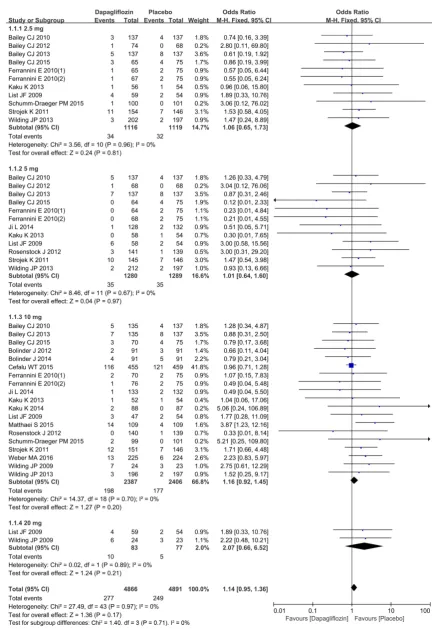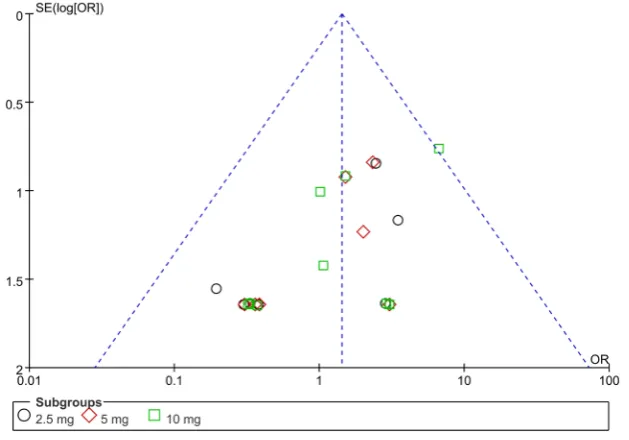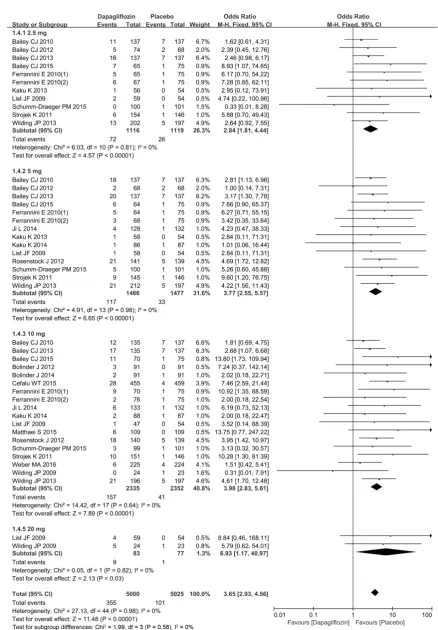ISSN Print: 2475-7330
DOI: 10.4236/ym.2018.23014 Aug. 30, 2018 129 Yangtze Medicine
Meta-Analysis on Safety of Dapagliflozin in
Patients with Type 2 Diabetes Mellitus
Lili She, Hongyan Wu
Yangtze University Medical School, Department of Endocrinology, Jingzhou First People’s Hospital, Yangtze University, Jingzhou, China
Abstract
Objective: To evaluate the safety of dapagliflozin for Type 2 Diabetes Melli-tus (T2DM). Methods: A systematic search of Pubmed, Embase, Cochrance Library, Web of Science, CNKI, Wanfang Data and VIP database for rando-mized controlled trials (RCTs) comparing dapagliflozin with placebo was performed up to February 2018. The index words included dapagliflozin, type 2 diabetes mellitus and randomized controlled trial. Results: A total of 19 RCTs involving 7704 participants were incorporated into the study. Com-pared with placebo, dapagliflozin did not increase the risk of hypoglycemia [OR = 1.14, 95%CI (0.95, 1.36), P = 0.17] and hypotension [OR = 1.43, 95%CI (0.94, 2.17), P = 0.10], but significantly increased the incidences of renal ad-verse events [OR = 1.57, 95%CI (1.17, 2.09), P = 0.002], genital tract infection [OR = 3.65, 95%CI (2.93, 4.56), P < 0.00001] and urinary tract infection [OR = 1.36, 95%CI (1.15, 1.61), P = 0.0004] and related doses. Conclusions: Gen-erally, dapagliflozin had no risk of hypoglycemia and hypotension in patients with T2DM, but there were risks of renal adverse events and urogenital tract infection. Due to the limitations of this study, larger samples and RCTs with long-term follow-up are needed for further verification.
Keywords
Dapagliflozin, Type 2 Diabetes Mellitus, Randomized Controlled Trial, Meta-Analysis
1. Introduction
As a common disease in China, the incidence of T2DM has been increasing year by year, and drug therapy is the main method of treatment. Sodium glucose co-transporter 2 (SGLT-2), as the most important glucose transporter in the kidney, is responsible for the reabsorption of 90% glucose in the kidney [1]. The How to cite this paper: She, L.L. and Wu,
H.Y. (2018) Meta-Analysis on Safety of Da-pagliflozin in Patients with Type 2 Diabetes Mellitus. Yangtze Medicine, 2, 129-145. https://doi.org/10.4236/ym.2018.23014
Received: May 5, 2018 Accepted: August 27, 2018 Published: August 30, 2018
Copyright © 2018 by authors and Scientific Research Publishing Inc. This work is licensed under the Creative Commons Attribution International License (CC BY 4.0).
DOI: 10.4236/ym.2018.23014 130 Yangtze Medicine further analyzed by retrieving RCTs of dapagliflozin versus placebo through meta-analysis.
2. Data and Methods
2.1. Criteria for Inclusion and Exclusion of Literature
Inclusion criteria:1) Research type: Included in the study were clinical RCTs of different doses of dapaglilfozin versus placebo in the treatment of T2DM officially published before February 2018; full text is available; languages are limited to Chinese and English.
2) Research object: Age > 18 years, in accordance with the diagnostic criteria for T2DM (WHO Committee of Experts on Diabetes 1999 diagnosis and classi-fication criteria), in accordance with the dapagliflozin guidelines.
3) Interventions: The experimental group was treated with dapagliflozan alone, regardless of dose size; placebo in the control group; or on the basis of other similar interventions.
Exclusion criteria:
Treatment observation time < 12 weeks, type 1 and special types of diabetes, review, non-RCT and so on.
2.2. Evaluation Index
Safety related indicators: hypoglycemia events, hypotension events, adverse renal reactions, genital tract infections, urinary tract infections.
2.3. Search Strategy
The search strategy follows the Preferred Reporting Items for Systematic Re-views and Meta-Analyses (PRISMA) statement [4]. Relevant studies for the analysis were selected by searching PubMed, Embase, Cochrance Library, Web of Science, CNKI, Wanfang Data and VIP database up to the end of February 2018. Taking Pubmed database as an example, subject words and free words are combined to search, and the retrieval scheme is as follows: #1 AND #2 AND #3.
DOI: 10.4236/ym.2018.23014 131 Yangtze Medicine OR Stable Diabetes Mellitus) OR Diabetes Mellitus, Type II) OR NIDDM) OR Diabetes Mellitus, Noninsulin Dependent) OR Diabetes Mellitus, Maturi-ty-Onset) OR Diabetes Mellitus, Maturity Onset) OR Maturity-Onset Diabetes Mellitus) OR Maturity Onset Diabetes Mellitus) OR MODY) OR Diabetes Mel-litus, Slow-Onset) OR Diabetes MelMel-litus, Slow Onset) OR Slow-Onset Diabetes Mellitus) OR Type 2 Diabetes Mellitus) OR Noninsulin-Dependent Diabetes Mellitus) OR Noninsulin Dependent Diabetes Mellitus) OR Maturity-Onset Di-abetes) OR Diabetes, Maturity-Onset) OR Maturity Onset DiDi-abetes) OR Type 2 Diabetes) OR Diabetes, Type 2) OR Diabetes Mellitus, Adult-Onset) OR Adult-Onset Diabetes Mellitus) OR Diabetes Mellitus, Adult Onset). #3 (((ran-domized controlled trial) OR ran(((ran-domized) OR placebo).
2.4. Data Extraction
Data were independently abstracted by the two principal reviewers and any dis-crepancies were resolved by consensus. The data extracted included title, author, and year of publication, country, intervention measures, sample size, patient age, treatment time, main outcome indicators and intentionality analysis.
2.5. Quality Assessment
Jadad scoring criteria were used [5], including 4 items: random method, assign-ment concealassign-ment, blind method and withdrawal. The RCT score was 1 - 7, 1 - 3 as low quality and 4 - 7 as high quality.
2.6. Data Analysis
Outcomes were pooled using Review Manager 5.3 software. Dichotomous data were presented as odds ratio (OR) or risk ratio (RR). All results were estimated from each study with 95% confidence intervals (CIs). Heterogeneity was assessed using the I2 statistic. If P > 0.1, I2 < 50%, a fixed-effect model with the Man-tel-Haenszel method was used; otherwise, the random-effect model was adopted. Subgroup analysis was performed according to the different doses of dapagliflo-zin (1 mg, 2.5 mg, 5 mg, 10 mg and 20 mg). Funnel plot was adopted to evaluate the publication bias. The bilaterally symmetric graph indicates a low risk of pub-lication bias. Otherwise, the risk of pubpub-lication bias may exist.
3. Results
DOI: 10.4236/ym.2018.23014 133 Yangtze Medicine Figure 1. Screening flow chart for inclusion studies.
3.2. Risk Assessment of Bias Included in the Study
Two reviewers independently applied the Cochrane Risk of Bias tool to assess the risk of bias in the RCTs. The following methodological features relevant to the minimization of bias were assessed: randomization, allocation concealment, blinding of participants and personnel, blinding of outcome assessment, incom-plete outcome data, selective reporting, and other bias. The following judgments were used: low risk, high risk, or unclear risk (either lack of information or un-certainty regarding the potential for bias). The bias risk assessment is shown in Figure 2.
4. Results of Meta-Analysis
4.1. Hypoglycemia Event
A total of 19 studies were implemented [3] [6]-[23] to compare hypoglycemia events. Heterogeneity was detected in study subgroups (2.5 mg, 5 mg, 10 mg, 20 mg), indicating that there was no statistically significant heterogeneity (I2 = 0%, P = 0.96), (I2 = 0%, P = 0.67), (I2 = 0%, P = 0.70), (I2 = 0%, P = 0.89) between studies included in the analysis (Figure 3). Therefore, the M-H fixation effect model was used for meta-analysis. Funnel plot of publication bias evaluation is presented in Figure 4. There was no risk of publication bias among subgroups in the study. No significant differences were observed in the comparison results of dapagliflozin with placebo in the incidence of hypoglycemia event [OR = 1.14, 95%CI (0.95, 1.36), P = 0.17], as shown in Figure 3.
4.2. Hypotension Event
DOI: 10.4236/ym.2018.23014 134 Yangtze Medicine (a)
[image:6.595.151.487.63.706.2]DOI: 10.4236/ym.2018.23014 136 Yangtze Medicine Figure 4. Funnel plot for publication bias evalution of dapagliflozin versus placebo for hypoglycemia events in patients with T2DM in different dose subgroups.
[image:8.595.151.535.297.693.2]DOI: 10.4236/ym.2018.23014 137 Yangtze Medicine effect model was used for meta-analysis. Funnel plot of publication bias evalua-tion is presented in Figure 6. There was no risk of publication bias among sub-groups in the study. No significant differences were observed in the comparison results of dapagliflozin with placebo in the incidence of hypotension event [OR = 1.43, 95%CI (0.94, 2.17), P = 0.10], as shown in Figure 5.
4.3. Renal Adverse Event
A total of 13 studies were implemented [3] [9] [10] [12] [13] [15]-[20] [22] [23] to compare renal adverse events. Heterogeneity was detected in study subgroups (2.5 mg, 5 mg, 10 mg), indicating that there was no statistically significant hete-rogeneity (I2 = 0%, P = 0.42), (I2 = 0%, P = 0.85), (I2 = 0%, P = 0.89) between studies included in the analysis (Figure 7). Therefore, the M-H fixation effect model was used for meta-analysis. Funnel plot of publication bias evaluation is presented in Figure 8. There was no risk of publication bias among subgroups in the study. Compared with placebo, dapagliflozin (10 mg subgroup) significantly increased the incidences of renal adverse events [OR = 1.57, 95%CI (1.17, 2.09), P = 0.002], as shown in Figure 7.
4.4. Genital Tract Infections
[image:9.595.217.532.478.698.2]A total of 19 studies were implemented [3] [6]-[23] to compare genital tract in-fections. Heterogeneity was detected in the study subgroups (2.5 mg, 5 mg, 10 mg, 20 mg), indicating that there was no statistically significant heterogeneity (I2 = 0%, P = 0.81), (I2 = 0%, P = 0.98), (I2 = 0%, P = 0.64), (I2 = 0%, P = 0.82) between studies included in the analysis (Figure 9). Therefore, the M-H fixa-tion effect model was used for meta-analysis. Funnel plot of publicafixa-tion bias evaluation is presented in Figure 10. There was no risk of publication bias among
DOI: 10.4236/ym.2018.23014 138 Yangtze Medicine Figure 7. Comparison of dapagliflozin versus placebo for renal adverse events in patients with T2DM in dif-ferent dose subgroups.
[image:10.595.231.517.498.695.2]DOI: 10.4236/ym.2018.23014 140 Yangtze Medicine Figure 10. Funnel plot for publication bias evalution of dapagliflozin versus placebo for genital tract infections in patients with T2DM in different dose subgroups.
subgroups in the study. Compared with placebo, dapagliflozin (2.5 mg, 5 mg, 10 mg, 20 mg subgroup) significantly increased the incidences of genital tract infec-tions [OR = 3.65, 95%CI (2.93, 4.56), P < 0.00001], as shown in Figure 9.
4.5. Urinary Tract Infections
A total of 19 studies were included [3] [6]-[23] to compare urinary tract infec-tions. Heterogeneity was detected in the study subgroups (1 mg, 2.5 mg, 5 mg, 10 mg, 20 mg), indicating that there was no statistically significant heterogeneity (I2 = 0%, P = 0.53), (I2 = 0%, P = 0.86), (I2 = 0%, P = 0.77), (I2 = 0%, P = 0.97), (I2 = 0%, P = 0.88) between studies included in the analysis (Figure 11). Therefore, the M-H fixation effect model was used for meta-analysis. Funnel plot of publi-cation bias evaluation is presented in Figure 12. There was no risk of publication bias among subgroups in the study. Compared with placebo, dapagliflozin (5 mg, 10 mg subgroup) significantly increased the incidences of urinary tract in-fections [OR = 1.36, 95%CI (1.15, 1.61), P = 0.0004], as shown in Figure 11.
5. Discussion
DOI: 10.4236/ym.2018.23014 141 Yangtze Medicine Figure 11. Comparison of dapagliflozin versus placebo for urinary tract infections in patients with T2DM in
DOI: 10.4236/ym.2018.23014 142 Yangtze Medicine Figure 12. Funnel plot for publication bias evalution of dapagliflozin versus placebo for urinary tract infections in patients with T2DM in different dose subgroups.
treatment group by contrast with the placebo group in patients with T2DM [30] [31] [32]. The higher risk of renal adverse events than placebo was associated primarily with the study by Cefalu WT et al., which involved a population with a history of type 2 diabetes mellitus associated with pre-cardiovascular disease, hypertension. They defined renal adverse events as renal damage, acute renal failure, decreased creatinine clearance, increased serum creatinine, and de-creased glomerular filtration rate, renal dysfunction and other serological indi-cators. For patients with stage 3 CKD or greater, dapagliflozin either requires dose adjustment or is contraindicated [33].
The 19 trials involved in this study are qualified English literature, all of which are single-center or multi-center studies with high methodological quality. There is no significant publication bias in all the literature, so the conclusions are relia-ble. However, a variety of factors such as the inclusion of subjects, patients with type 2 diabetes, disease severity, duration of illness, combination of other dis-eases with dapagliflozin dose and medication time may increase the clinical he-terogeneity of the study.
Conflicts of Interest
The authors declare no conflicts of interest regarding the publication of this paper.
References
[1] Lee, Y.J. and Han, H.J. (2007) Regulatory Mechanisms of Na(+)/Glucose Cotrans-porters in Renal Proximal Tubule Cells. Kidney International, 106, S27-S35.
https://doi.org/10.1038/sj.ki.5002383
[2] Gerich, J.E. (2010) Role of the Kidney in Normal Glucose Homeostasis and in the Hyperglycaemia of Diabetes Mellitus: Therapeutic Implications. Diabetic Medicine, 27, 136-142. https://doi.org/10.1111/j.1464-5491.2009.02894.x
DOI: 10.4236/ym.2018.23014 143 Yangtze Medicine
Patients with Type 2 Diabetes Mellitus: A Randomized, Blinded, Prospective Phase III Study. Clinical Therapeutics, 36, 84-100.
https://doi.org/10.1016/j.clinthera.2013.11.002
[4] Knobloch, K., Yoon, U. and Vogt, P.M. (2011) Preferred Reporting Items for Sys-tematic Reviews and Meta-Analyses (PRISMA) Statement and Publication Bias.
Journal of Cranio-Maxillo-Facial Surgery, 39, 91-92.
https://doi.org/10.1016/j.jcms.2010.11.001
[5] Jadad, A.R., Moore, R.A., Carroll, D., et al. (1996) Assessing the Quality of Reports of Randomized Clinical Trials: Is Blinding Necessary? Controlled Clinical Trials, 17, 1-12. https://doi.org/10.1016/0197-2456(95)00134-4
[6] List, J.F., Woo, V., Morales, E., et al. (2009) Sodium-Glucose Cotransport Inhibition with Dapagliflozin in Type 2 Diabetes. Diabetes Care, 32, 650-657.
https://doi.org/10.2337/dc08-1863
[7] Bailey, C.J., Gross, J.L., Pieters, A., et al. (2010) Effect of Dapagliflozin in Patients with Type 2 Diabetes Who Have Inadequate Glycaemic Control with Metformin: A Randomised, Double-Blind, Placebo-Controlled Trial. Lancet, 375, 2223-2233.
https://doi.org/10.1016/S0140-6736(10)60407-2
[8] Ferrannini, E., Ramos, S.J., Salsali, A., et al. (2010) Dapagliflozin Monotherapy in Type 2 Diabetic Patients with Inadequate Glycemic Control by Diet and Exercise: A Randomized, Double-Blind, Placebo-Controlled, Phase 3 Trial. Diabetes Care, 33, 2217-2224. https://doi.org/10.2337/dc10-0612
[9] Bolinder, J., Ljunggren, Ö., Kullberg, J., et al. (2012) Effects of Dapagliflozin on Body Weight, Total Fat Mass, and Regional Adipose Tissue Distribution in Patients with Type 2 Diabetes Mellitus with Inadequate Glycemic Control on Metformin.
The Journal of Clinical Endocrinology & Metabolism, 97, 1020-1031.
https://doi.org/10.1210/jc.2011-2260
[10] Strojek, K., Yoon, K.H., Hruba, V., et al. (2011) Effect of Dapagliflozin in Patients with Type 2 Diabetes Who Have Inadequate Glycaemic Control with Glimepiride: A Randomized, 24-Week, Double-Blind, Placebo-Controlled Trial. Diabetes Obesity and Metabolism, 13, 928-938. https://doi.org/10.1111/j.1463-1326.2011.01434.x [11] Bailey, C.J., Iqbal, N., T’joen, C., et al. (2012) Dapagliflozin Monotherapy in
Drug-Naïve Patients with Diabetes: A Randomized-Controlled Trial of Low-Dose Range. Diabetes Obesity and Metabolism, 14, 951-959.
https://doi.org/10.1111/j.1463-1326.2012.01659.x
[12] Rosenstock, J., Vico, M., Wei, L., et al. (2012) Effects of Dapagliflozin, an SGLT2 Inhibitor, on HbA1c, Body Weight, and Hypoglycemia Risk in Patients with Type 2 Diabetes Inadequately Controlled on Pioglitazone Monotherapy. Diabetes Care, 35, 1473-1478. https://doi.org/10.2337/dc11-1693
[13] Wilding, J.P., Woo, V., Soler, N.G., et al. (2013) Long-Term Efficacy of Dapagliflo-zin in Patients with Type 2 Diabetes Mellitus Receiving High Doses of Insulin.
Dtsch Med Wochenschr, 138, S27-S38. https://doi.org/10.1055/s-0032-1305284 [14] Kaku, K., Inoue, S., Matsuoka, O., et al. (2013) Efficacy and Safety of Dapagliflozin
as a Monotherapy for Type 2 Diabetes Mellitus in Japanese Patients with Inadequate Glycaemic Control: A Phase II Multicentre, Randomized, Double-Blind, Place-bo-Controlled Trial. Diabetes Obesity and Metabolism, 15, 432-440.
https://doi.org/10.1111/dom.12047
DOI: 10.4236/ym.2018.23014 144 Yangtze Medicine https://doi.org/10.1111/dom.12325
[18] Schumm-Draeger, P.M., Burgess, L., Korányi, L., et al. (2015) Twice-Daily Dapag-liflozin Co-Administered with Metformin in Type 2 Diabetes: A 16-Week Rando-mized, Placebo-Controlled Clinical Trial. Diabetes, Obesity and Metabolism, 17, 42-51. https://doi.org/10.1111/dom.12387
[19] Matthaei, S., Bowering, K., Rohwedder, K., et al. (2015) Dapagliflozin Improves Glycemic Control and Reduces Body Weight as Add-On Therapy to Metformin plus Sulfonylurea: A 24-Week Randomized, Double-Blind Clinical Trial. Diabetes Care, 38, 365-372. https://doi.org/10.2337/dc14-0666
[20] Cefalu, W.T., Leiter, L.A., de Bruin, T.W., et al. (2015) Dapagliflozin’s Effects on Glycemia and Cardiovascular Risk Factors in High-Risk Patients with Type 2 Di-abetes: A 24-Week, Multicenter, Randomized, Double-Blind, Placebo-Controlled Study with a 28-Week Extension. Diabetes Care, 38, 1218-1227.
https://doi.org/10.2337/dc14-0315
[21] Wilding, J.P., Norwood, P., T’joen, C., et al. (2009) A Study of Dapagliflozin in Pa-tients with Type 2 Diabetes Receiving High Doses of Insulin plus Insulin Sensitizers: Applicability of a Novel Insulin-Independent Treatment. Diabetes Care, 32, 1656-1662. https://doi.org/10.2337/dc09-0517
[22] Bailey, C.J., Morales Villegas, E.C., Woo, V., et al. (2015) Efficacy and Safety of Da-pagliflozin Monotherapy in People with Type 2 Diabetes: A Randomized
Double-Blind Placebo-Controlled 102-Week Trial. Diabetic Medicine, 32, 531-541. https://doi.org/10.1111/dme.12624
[23] Weber, M.A., Mansfield, T.A., Cain, V.A., et al. (2016) Blood Pressure and Glycae-mic Effects of Dapagliflozin versus Placebo in Patients with Type 2 Diabetes on Combination Antihypertensive Therapy: A Randomised, Double-Blind, Place-bo-Controlled, Phase 3 Study. The Lancet Diabetes & Endocrinology, 4, 211-220. https://doi.org/10.1016/S2213-8587(15)00417-9
[24] Ji, L.N., Hu, D., Pan, C., et al. (2013) Primacy of the 3B Approach to Control Risk Factors for Cardiovascular Disease in Type 2 Diabetes Patients. American Journal of Medicine, 126, 925.e11-22.https://doi.org/10.1016/j.amjmed.2013.02.035
[25] Zhang, M., Zhang, L., Wu, B., et al. (2014) Dapagliflozin Treatment for Type 2 Di-abetes: A Systematic Review and Meta-Analysis of Randomized Controlled Trials.
Diabetes/Metabolism Research and Reviews, 30, 204-221.
https://doi.org/10.1002/dmrr.2479
[26] Weber, M.A., Mansfield, T.A., Alessi, F., et al. (2016) Effects of Dapagliflozin on Blood Pressure in Hypertensive Diabetic Patients on Renin-Angiotensin System Blockade. Blood Press, 25, 93-103. https://doi.org/10.3109/08037051.2015.1116258
[27] Solini, A., Giannini, L., Vitolo, E., et al. (2017) Dapagliflozin Acutely Improves En-dothelial Dysfunction, Reduces Aortic Stiffness and Renal Resistive Index in Type 2 Diabetic Patients: A Pilot Study. Cardiovascular Diabetology, 16, 138.
DOI: 10.4236/ym.2018.23014 145 Yangtze Medicine
[28] Shigiyama, F., Kumashiro, N., Miyagi, M., et al. (2017) Effectiveness of Dapagliflo-zin on Vascular Endothelial Function and Glycemic Control in Patients with Ear-ly-Stage Type 2 Diabetes Mellitus: Defence Study. Cardiovascular Diabetology, 16,
84.https://doi.org/10.1186/s12933-017-0564-0
[29] Sonesson, C., Johansson, P.A., Johnsson, E., et al. (2016) Cardiovascular Effects of Dapagliflozin in Patients with Type 2 Diabetes and Different Risk Categories: A Meta-Analysis. Cardiovascular Diabetology, 15, 37.
https://doi.org/10.1186/s12933-016-0356-y
[30] Petrykiv, S., Sjostrom, C.D., Greasley, P.J., et al. (2017) Differential Effects of Da-pagliflozin on Cardiovascular Risk Factors at Varying Degrees of Renal Function.
Clinical Journal of the American Society of Nephrology, 12, 751-759.
https://doi.org/10.2215/CJN.10180916
[31] Kohan, D.E., Fioretto, P., Johnsson, K., et al. (2016) The Effect of Dapagliflozin on Renal Function in Patients with Type 2 Diabetes. Journal of Nephrology, 29, 391-400.https://doi.org/10.1007/s40620-016-0261-1
[32] Fioretto, P., Stefansson, B.V., Johnsson, E., et al. (2016) Dapagliflozin Reduces Al-buminuria over 2 Years in Patients with Type 2 Diabetes Mellitus and Renal Im-pairment. Diabetologia, 59, 2036-2039.https://doi.org/10.1007/s00125-016-4017-1









